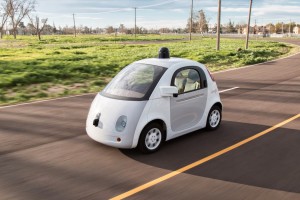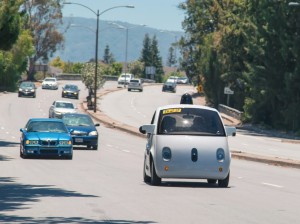
Opponents to Google's plans for a car with no steering wheel, gas pedal or brake pedal claim recent events support their position.
California, which seems to be the location for the largest number of self-driving test vehicles, recently released its proposed rules for autonomous vehicles. Chief among them? Steering wheels and gas and brake pedals.
Not a big deal … unless you’re Google, which wants its vehicles to have nothing more than a big red button to shut the vehicle down.
For obvious reasons, Google is protesting, calling the move “gravely disappointing,” but the tech giant’s own data is adding fuel to the fire for opponents that the company’s desire for just the red button is enough to keep roads safe. The company said in a recent state-mandated disengagement report that test vehicles turned control over to the test driver more than 270 times.
“The DMV got it exactly right and is putting our safety first,” said John M. Simpson, Consumer Watchdog’s Privacy Project director. Consumer Watchdog is leading the charge against Google’s effort to eliminate the vehicle controls from its final product.
(Google says it’s looking for partners, but won’t comment on Ford deal. For more, Click Here.)
“How can Google propose a car with no steering wheel, brakes or driver when its own tests show that over 15 months the robot technology failed and handed control to the driver 272 times and a test driver felt compelled to intervene 69 times?”
Currently California regulations for autonomous cars require a driver behind a steering wheel capable of taking control. Google claims the vehicle’s setting during the 14-month period are “very conservative” and the disengagements are precisely how the company is working out the bugs.
Most of these events – 89% – occurred during testing on city streets, which often feature the highest number of variables for the system to discern.
“Our test drivers are trained and prepared for these events and the average driver response time of all measurable events was 0.84 seconds,” the company said in the report. “As we continue to develop and refine the self-driving software, we are seeing fewer disengagements of this type despite a growing number of miles driven each month.”
(Getting to full autonomy will be difficult, cautions new Toyota research chief. Click Here to learn why.)
Simpson is calling for Google to release the videos of these events as well as any technical data “so we can fully understand what went wrong as it uses our public roads as its private laboratory.”
For its part, Google sees the events as critical to the development of the vehicles. Engineers using a simulator program “replay” each incident and predict the behavior of the self-driving car, if the driver had not assumed control, as well as other road users.
“The simulator can also create thousands of variations on that core event so we can evaluate what would have happened under slightly different circumstances, such as our vehicle and other road users moving at different times, speeds, and angles,” the company said in the report.
In all, 11 companies – Volkswagen Group of America, Mercedes Benz, Google, Delphi Automotive, Tesla Motors, Bosch, Nissan, Cruise Automation, BMW, Honda and Ford – are approved to test self-driving cars on California roads. They are also required to submit disengagement reports.
(NHTSA planning to make three “history-making” announcements. Click Here for this breaking story.)
For example, Nissan reported 106 incidents in the seven months of testing it conducted over 1,485.4 miles while Mercedes-Benz reported 1,031 disengagements between two vehicles over 14 months 1,739 miles. Google had nearly three times as many incidents as the other two, but their vehicles covered 424,331 miles during the period.


It’s about time the TRUTH came out on the Google AV cars and the problems caused by improper programming and improper operation of these vehicles. The rush to market mentality is going to get innocent people killed because the Feds have been negligent in not establishing mandatory safety, security, manufacture and maintenance laws for AVs.
We have one report on the 270 times a Google AV car malfunctioned yet this is evidently unimportant because we don’t read about these clear safety issues day after day like with trivial automotive issues. We don’t hear NHTSA demanding an investigation due to the safety issues. We don’t see the media contacting “their sources” to get the full report and speculation on these Google car incidents. WHY don’t we see investigations by NHTSA and other appropriate agencies?
These are the people and cars that are being rushed to market for a quick profit while endangering the lives of many yet no one actually cares about 270 incidents where the driver had to take control of the vehicles? Time to wake up people. Those Google AVs could be planning to drive into your vehicle next. Why is this serious safety matter unimportant to the media and general public? Why isn’t this front page news when so many lives will be in danger when AVs hit the streets? Why have the Feds failed to issue mandatory AV safety systems, design parameters and operational competency for AVs NOW before they are on the roadways and crashing?